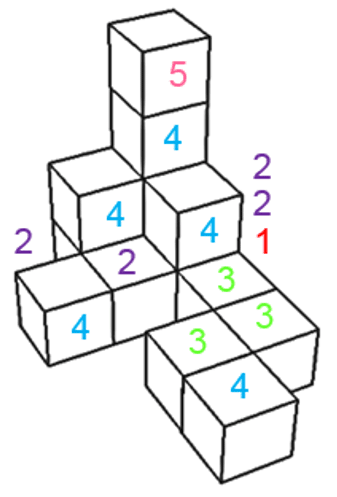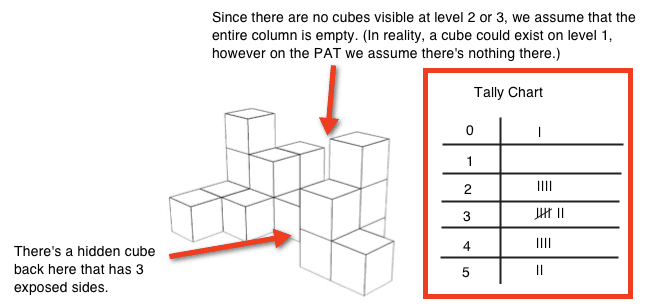The Perceptual Ability Test (PAT) is the second section of the DAT. It is one of the most challenging sections of the DAT for many students. The DAT PAT tests your spatial visualization skills, including your ability to interpret two-dimensional (2D) representations of three-dimensional (3D) objects. DAT PAT cube counting is one of the sections that is considered to be the easiest one among others.

These DAT Perceptual Ability skills will be very useful to you as a dentist since you will need to construct mental images of teeth from X-rays, deal with casts and fillings, and otherwise work with complicated 2D and 3D objects.
The PAT contains a total of 90 questions that you must complete within 60 minutes. The 90 questions are divided into six categories consisting of 15 questions each: Keyholes (apertures), Top-Front-End (view recognition), Angle Ranking, Hole Punching (paper folding), Cube Counting, and Pattern Folding (3D form development). All the questions for a given subsection appear together, and the subsections always appear in the same order. The American Dental Association has released a practice test they call the Sample Test Items that shows how the PAT questions looked when the DAT was administered on paper. Since then, the DAT has changed to be a computer-based test, but the format is still similar.
Some question types are more time-consuming than others, so you’ll need to pace yourself accordingly rather than only considering the average amount of time per question for the entire section.
These questions tend to be the fastest because they only involve 2D images and should take you approximately 20 seconds each.
These questions require an understanding of how 2D images correspond with 3D shapes and will likely take closer to 50 seconds each.
These questions also require 2D-to-3D manipulation and tend to be some of the most challenging, so they may take up to 60 seconds each.
This section is unique because it contains several questions associated with one figure, so it is easier to think about it as taking two minutes per figure (which corresponds to about 40 seconds per question).
Cube-counting is one of the four sections of the PAT that you can easily ace. Plus, it's pretty fun. Cube counting can also raise your confidence levels going into paper folding (assuming you follow the natural order of the PAT). Let's get into it with a quick overview of what this section is all about.

In this section, you are given a figure where it is made by cementing cubes of the same size together. The figure is then painted on all sides EXCEPT for the bottom on which it is resting. The only hidden cubes are those requires to support other cubes. Then you will be asked questions such as “how many cubes have three of their sides painted?” or “How many cubes have four/five of their sides painted/exposed?” For the following questions, you are to examine each figure to determine how many cubes have either
The most common method for answering cube counting questions is the tally table. In this method, you draw a table. On the left side of the table, we have the number of sides painted in a cube, and on the right side, we have the number of cubes with that many sides painted.
We start from a column/row and count the sides painted for each cube in that column/row and draw a tally in front of each line for every cube we do, and only then do we move on to the next column/row of cubes until there are no more columns/rows left. If that makes you confused you could also go for counting the cubes in each level, find the counting method that suits you.

The best way to approach the cube-counting section is by using a method called the "T-Table Technique". With this method, the student draws a T-table on the provided sheet of paper and systematically analyzes the figure while categorizing cubes by the number of faces that are painted. For an organization, it is best to pick a row or column, to begin with, and move on only after marking each cube in the row/column. However, the order in which each cube is counted does not matter so as long as no duplicate marking occurs. Let's see this method in practice.
1. Identify any row/column, to begin with
2. Begin analyzing cubes and work your way back and up
3. Continue until all cubes have been accounted for
It is important to note that the approach to where to start and how to progress along the figure is highly customizable. Start with the side that feels most natural to you and with practice, this will become second nature! It is also important to mention that although the tally chart includes "0" for completion, this will likely never be tested on the DAT so feel free to omit it for efficiency purposes.
Similarly, do not waste time labeling the tally chart with the header text. At the end of the day, your goal on test day is to be as efficient as you possibly can! For example, as a final check, one might want to count all tally marks to see if it matches up with the total cube count in the figure. However, with practice and confidence, this checking step can be ignored as it takes up valuable time. You are also encouraged to modify strategies so they fit your test-taking style.
Another method you can use is finding symmetry between rows/columns or finding a sister or a twin so to speak for a row/column with the same number of faces painted. If you find it, then instead of spending time to count the painted faces all over again, you can just double the results you got from the identical row/column that you did already for this one.

An important factor to becoming a master at cube-counting concerns figure symmetry. In the examples above, scan each cube in the figure separately but if a particular row/column has a sister row/column, then double the tally marks. This drastically reduces the amount of time one has to spend on each figure.
You are also encouraged to modify strategies so they fit your test-taking style. Now let’s look that some general PAT guidelines that can improve your preparation from being good to being great!
Here are some general guidelines that you should follow to help you obtain a higher overall score:
1. Elimination: Look at the possible answers for each question and find which ones you can eliminate. Eliminating answers will help you get rid of the distractors and come up with the right answer more quickly. This is a helpful thing to do with every question on the DAT; there are distractors on every question.
2. Time Management: Make sure you are completing the subtests in a timely manner. You have 40 seconds max per question so you can't afford to waste time on this test. The best way to become efficient in your time management on the PAT is to follow the following guidelines.
3. Practice: Do practice problems!
4. Practice: Do more practice problems!
5. Practice: Do even more practice problems! Do as many practice tests as you can for the PAT; the more the better! This is the only way to crush the PAT.
These DAT Perceptual Ability skills will be very useful to you as a dentist since you will need to construct mental images of teeth from X-rays, deal with casts and fillings, and otherwise work with complicated 2D and 3D objects. The DAT- Perceptual Ability (PAT) part of the test may seem difficult for some but the key to cracking any exam, as mentioned before, is to practice, practice, and then practice some more.
The counting cube section is the easiest part which is why it can give participants a good opportunity to score a good number with it to get one step closer to acing DAT. Looking for a tool that can provide you with the best top-rated resources to crush the PAT? Get Started Free with PATCrusher today, and get unlimited practice questions, growth analytics, goal analysis, and detailed explanations!